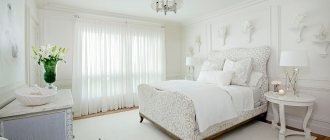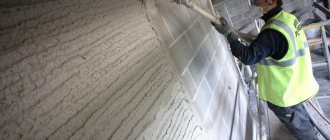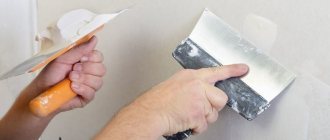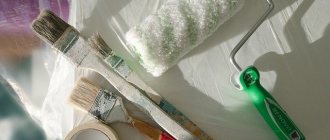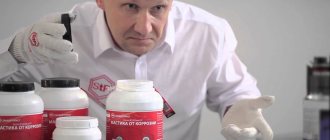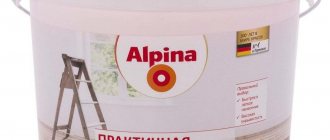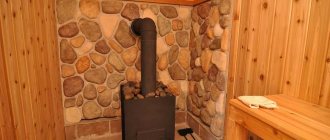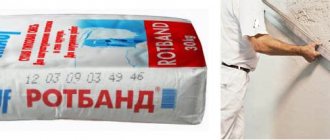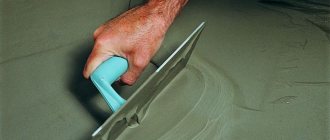One of the modern interior trends that is confidently gaining popularity is wall painting. It would seem that monotony is quite boring, but most designers are right in their unanimity: painted walls serve as a neutral canvas for expressing style in details, furniture and accessories and look much better than a repeating finished pattern. At first glance, this is the simplest type of decoration, but there are features in painting walls that need to be taken into account.
Today, together with specialists from Meffert AG, a manufacturer of düfa paint and varnish products, we will talk about what paints are now in fashion, how to prepare a base for them, and which coatings forgive flaws and which require an ideal surface.
Rating of the best paints for walls
In many ways, the choice of one type of paint or another depends on the operating conditions of the surfaces in the room where the walls are to be painted, the microclimate in it, as well as the material of the walls. The highest load on the wall material occurs in the kitchen. This is due to increased humidity, moisture, grease, hot steam, and other contaminants on the walls. Therefore, it is better to choose latex or silicone paint here. Acrylic compositions can be chosen for living rooms and bedrooms. To paint the walls in a nursery, it is better to choose a composition that has the appropriate mark on the packaging.
The best water-soluble compounds
The popularity of this paint is due to its low cost and practicality:
- it dries quickly;
- Can be easily painted in any color using a pigment;
- does not smell;
- Suitable for most grounds.
The disadvantages of inexpensive emulsions are poor mechanical resistance, rapid contamination, and fear of moisture. This material is only suitable for painting ceilings in rooms with normal humidity.
Interior emulsion "Universal" from "TEX"
For painting walls in the bedroom, living room, nursery and other rooms with normal humidity levels. After drying, a vapor-permeable coating with a matte effect is formed on the surface of the walls. The paint adheres well, evenly covers concrete, plastered, brick, wood and plasterboard substrates, and is economical in consumption. Initially white paint can be tinted to any shade if necessary.
pros
- environmental friendliness;
- does not smell;
- quick drying;
- economical consumption;
- affordable price;
- does not form splashes or drips.
Minuses
- not suitable for rooms with high humidity.
Interior emulsion “Profi” from “TEX”
A multifunctional composition that can be used in rooms with dry and humid microclimates - kitchen, bathroom, bedroom, living room, children's room. After the paint dries, a “breathing” and very durable, wear-resistant layer is formed on the surface of the walls. Suitable for most types.
pros
- can be tinted;
- hiding power;
- has no smell;
- dries quickly;
- economical consumption;
- does not form splashes or drips.
Minuses
Interior emulsion from LAKRA
Water-dispersion paint forms a matte, uniform coating after drying. Available in white. Can be tinted in light shades. 1 kg of paint is enough for an average of 6-8 m2. It is used for painting walls in rooms with normal microclimate and humidity. Excellent coloring of porous surfaces.
pros
- economical consumption;
- durable front layer;
- adhesion to the base;
- can be washed.
Minuses
- there is a smell.
Paint "Vinyl Matt base BW" from "Dulux"
After drying, it creates a deep matte finish on the surface. It is characterized by high smoothness. Masks the imperfections of the base. Can be tinted in any shade according to all current catalogs. The paint is easy to apply, does not leak or splash.
pros
- does not smell;
- can be washed;
- lays down evenly and masks imperfections in the base.
Minuses
- high price.
Acrylic
Acrylic-based dyes are the most common material for giving the desired look to fabric.
This paint has the following advantages:
- Dilution in water – reduces product consumption and minimizes the release of toxic substances;
- Quick drying – speeds up the painting process;
- Mixing different colors helps create a unique palette.
It is recommended to paint natural fibers with acrylic paint - cotton, silk, linen. The finished fabric can be washed by hand at temperatures up to 30 degrees Celsius.
The best acrylic compounds
Paint with an acrylic base forms a thin protective coating that is resistant to mechanical stress and moisture. This type of coating paints equally well on concrete and wood surfaces. The main condition is that the base surface must be carefully prepared and leveled.
Paint "Optimum"
The paint is used to paint walls and ceilings. Suitable for finishing new and putty-prepared concrete, aerated concrete, brick, plasterboard and wooden bases. The paint is intended for rooms with normal humidity. Creates a deep matte finish.
pros
- does not create glare;
- lays down evenly;
- economical consumption;
- dries quickly.
Minuses
- dry cleaning only.
Acrylic-based paint "Alpina Renova"
Interior paint from the Caparol Group under the Alpina Renova brand can often be found at the top of the ratings. After painting, it creates a matte finish that remains perfectly snow-white throughout the entire service life of the decorative layer - from 5 to 7 years. The paint can be tinted perfectly in any shade. Experts recommend using a coloring pigment from the same manufacturer. This will preserve the durability of the coating and the brightness of the shade. The paint is universal and can be used for painting walls in rooms with temperature changes and high humidity.
pros
- easy care of the coating;
- after wet cleaning, the intensity of the shade is maintained;
- excellent adhesion to the base;
- Not too thick and not runny consistency.
Minuses
- high consumption.
“Joker” paint from “Tikkurila” acrylic
Eco-friendly acrylic-based matte paint, recommended for painting walls in children's rooms and bedrooms. It is diluted with water and has no odor. Suitable for porous substrates - concrete, brick, plaster, as well as gypsum board. Dries in 5 hours. You can apply it using a spray gun or manually (brush, roller).
pros
- hiding power;
- thick consistency;
- no smell;
- dries quickly;
- can be washed.
Minuses
- high price.
Paint “PL-07A” from “Profilux”
Paint for finishing walls in rooms with a normal microclimate. The composition is easy to apply, it does not spread, does not form streaks. Creates a uniform matte layer on the surface. Suitable for any substrate. After drying, it can be subjected to light wet cleaning. Water is used for dilution.
pros
- environmental friendliness;
- without smell;
- uniform layer.
Minuses
- long drying time.
Paint "Weiss" from "ECO" on an acrylic basis
Abrasion-resistant, deep-matte, environmentally friendly paint made in Germany for walls and ceilings. It is characterized by high wear resistance and vapor permeability. Suitable for painting wallpaper. Water is used for dilution.
pros
- no odor;
- environmental friendliness;
- long lasting color;
- hiding power;
- doesn't smell.
Minuses
- not detected.
Painting fabric (step by step instructions)
The application of paint to clothing can be partial or complete, manual or automatic. Since the target audience does not have a stencil for silk-screen printing, the paint will have to be applied manually.
The exception is the use of a washing machine. Sometimes, when the item rotates inside the drum, the paint is applied unevenly, and the washing machine itself becomes dirty.
Therefore, it is better to carry out full painting of the product inside a deep basin. In any case, tissue renewal occurs in stages:
- First you need to draw a sketch and design your future clothes;
- Next, the product is treated with etching paint to destroy the previous background with a pattern;
- The next stage is preparing a solution according to the origin of the dye;
- Next, the product is immersed in a solution to create a background;
- The dried background is decorated using a stencil.
For better resistance to washing powders, the background is painted in two or three layers. Decor can be applied with a brush or marker. To prevent the print from extending beyond the stencil, cellophane film is placed under it and on the back side of the fabric.
A slightly heated iron promotes the formation and accelerated drying of the print. However, when using quick-drying acrylic, you can avoid applying an iron over the design.
The best silicone compounds
Paint with silicone resins appeared on the construction market not so long ago, but has already gained popularity due to its unique characteristics. These are universal compositions for interior and exterior wall decoration, resistant to mechanical stress, sunlight, and atmospheric conditions. The coating has heat resistance and antiseptic properties. The main disadvantage is the cost. It is higher than other types of interior paint. Most often you can find acrylic paint containing silicone on sale.
Paint "Caparol" "CapaSilan"
This durable matte paint does not contain solvents. The main advantage of this paint is that when applied even in a poorly lit room, a uniform monolithic coating is obtained on the wall without noticeable overlap of adjacent areas. The composition of the paint meets current sanitary standards. The coating is suitable for porous substrates and has high hiding power. “Caparol” “CapaSilan” paint can be used in rooms with high requirements for environmental friendliness and hygiene of finishing materials.
pros
- easy to apply;
- there is a water-repellent effect;
- can be washed and used in rooms with high humidity.
- hiding power.
Minuses
- high price.
Paint "Euro Extra 20" from "TIKKURILA"
Paint from a recognized leader in Finnish-made paints and varnishes. This type of silicone paint has some of the advantages that only silicone paint can have: color purity, resistance to sunlight, water resistance. The paint is easy to apply, odorless, and the coating can be washed with standard detergents.
pros
- environmentally friendly composition;
- easy application;
- UV resistance;
- long service life of the coating;
- moisture resistance;
- no smell.
Minuses
- high price.
Paint "Litotherm Paint Sil" from "LITOKOL"
Reliable protection of the base from external influences, moisture and dirt, as well as resistance to UV, combined with an affordable cost, have made LITOKOL brand silicone paint a popular product with the characteristics of a Premium category material. One of the advantages is a wide range of shades. The downside is that a high-quality and durable decorative coating can only be obtained by using other products (plaster, putty, primer) together with this paint.
pros
- moisture-resistant coating that can be washed;
- large selection of shades;
- resistance to external influences.
Minuses
- compatible only with LITOKOL brand materials.
Varnish
The material protects against moisture and mechanical damage. It is used when you want to add shine to a matte surface. When finishing premises, acrylic water-soluble varnishes are used. Craquelure varnish is suitable for creating artificial cracks. When working with facades, compositions based on organic solvents are used.
Before use, you can add dyes of the desired color or glitter to the varnish. After thorough mixing, apply the coating in 1 layer with a foam roller, sponge or brush.
The best latex compounds
The aqueous emulsion contains latex copolymers. This makes the paint layer durable and waterproof. Therefore, latex paint can often be found on the walls in the bathroom or kitchen. The peculiarity of this paint is that it forms a thin protective film on the surface and does not overlap the texture of the base, which allows it to be used to protect artificial stone or brick in the decor of a kitchen or bathroom.
NewTone Sky paint
For a super white finish, use this latex paint. It is recommended to use it in rooms with a dry microclimate and normal humidity levels. The paint is suitable for all types of substrates - brick, wood, concrete, plasterboard and plaster. With the help of color you can get any shade.
pros
- environmental friendliness;
- affordable price;
- versatility.
Minuses
- not economical consumption;
- poor hiding power.
Paint "Retail Eurolatex 3" from "Dufa"
Paint from a German manufacturer with the highest European quality has an affordable price. Economical consumption and high hiding power make the work process easier. On the surface, the paint creates a durable, washable coating. To remove dirt, you can use detergents containing alkali. This allows the paint to be used in the kitchen.
pros
- durable durable coating;
- hiding power;
- resistance to alkali.
Minuses
- paint with colored pigment dries and darkens.
3D White paint from Dulux
Latex super white paint with a matte effect for wallpaper, drywall, plaster, concrete and brick surfaces. Can be tinted. Dries in 4 hours. Applied manually and mechanized. Dilute with water.
pros
- snow-white;
- hiding power;
- without smell;
- can be washed.
Minuses
- high price.
Bindo 7 BW paint from Dulux
Professional paint and varnish material with a matte effect. Lays down smoothly and does not form smudges or splashes when applied with a brush or roller. The paint is intended for use in rooms with high hygiene requirements for finishing materials. The environmentally friendly composition allows you to use this latex paint in the kitchen and children's room. Perfectly emphasizes the relief of textured wallpaper for painting. After drying, the decorative layer can be washed with mild detergents and non-abrasive sponges.
pros
- environmentally friendly composition;
- economical consumption;
- hiding power.
Minuses
- price.
Paint "Retail Eurolatex 7" from "Dufa"
Paint with high hiding power and matte texture at an affordable price. It is characterized by economical consumption, simple, high-quality application and quick drying (24 hours). The coating can be washed. Water is used for dilution. Suitable for all types of bases.
pros
- environmental friendliness;
- affordable price;
- economical consumption;
- doesn't smell.
Minuses
- not detected.
Wax on plaster
Wax compositions can be:
- Synthetic. This wax has water-repellent properties and is resistant to temperature changes. Synthetic wax can be applied with almost any tool.
- Gel-like. The compositions are applied with rubber spatulas.
- Liquid. Wax is used for any type of surface. It is advisable to apply it with a cloth.
Compositions including wax are used in the final stages of painting decorative plaster.
Their use helps:
- enhance color brightness;
- give a glossy shine;
- protect from moisture;
- deepen the relief surface;
- change the color of Moroccan or Venetian plaster walls.
You can add glitter (sparkles) or pigment to the wax. In this case, the composition must be constantly stirred to maintain its homogeneity. Within 3-4 hours after application, the wax layer can be corrected.
Requirements for interior paint
When choosing a paint, they take into account not only its shade, but also its composition, which determines the technical parameters of the material. Here are the most important:
- Coverage level. The ability of paintwork materials to cover the shade and texture of the base depends on this parameter. With high hiding power, few layers are required to achieve an even shade. The higher this parameter, the less paint consumption will be, which means the cheaper the repair will be.
- Compositions with high vapor permeability have the ability to “breathe”. This criterion is especially important when painting walls in rooms with high humidity. Natural ventilation of the paint layer will prevent the formation of fungus and mold due to the free evaporation of moisture.
- Paintwork materials have varying degrees of resistance to moisture, wear and mechanical stress. All these indicators determine the durability of the paint layer.
To complete the repair as quickly as possible, you should pay attention to the drying speed of the paint. The manufacturer indicates this information on the packaging.
Paintable surface options
Painting work is performed at the end of the renovation. In this case, the main tasks of painting a wall are:
- protection of the wall material from destruction, increasing service life;
- improving the sanitary and hygienic condition of the premises;
- decorative design of the interior and exterior of the building.
You can get the desired result by performing several steps, which are not limited to selecting paint colors. It is necessary to select its type and performance properties for the surface to be painted - different paints interact differently with base materials. In this case, you need to start from the type of room and the requirements for the final durability of the coating.
Also, the quality of the work performed is directly influenced by the correct preparation of the surface for painting. We should not forget about the technology of applying the material to previously painted or new surfaces - violation of the manufacturer’s instructions can lead to film cracks, peeling, etc. In 60% of cases, a poor result is obtained with an insufficiently prepared surface.
Concrete
The concrete base collects dust well, which does not look very aesthetically pleasing and makes it difficult to restore final order in the apartment after renovation. Therefore, 90% of it is covered with paint. For this purpose, acrylic and alkyd paints are mainly used - almost any of the listed options are suitable for treating concrete indoors. Alternative options are decorating with plaster or clear varnish if the interior design is planned with untreated concrete walls.
Before painting, the surface should be dust free using a transparent primer. After treatment, the pores of the concrete will be filled with primer, which will allow the paint to lay down in an even, dense layer. This will also reduce the consumption of base material.
Drywall
Plasterboard structures must be prepared before painting: putty and sand. Painting compounds cannot be applied directly to drywall sheets. Finishing can be done with any paint, but the best results are obtained by using water-based paints.
Plaster
Plastered walls provide texture and can be painted without additional putty. You can start finishing the plaster only after it has completely dried and it is best to use water-based paints. To ensure high-quality adhesion of the composition to the base, it is primed several times. In rooms with a lot of moisture, the plaster is treated with an antifungal agent before painting.
Brick
Brick in the interior and exterior itself looks good, but if you decide to paint it, know that you will have to repeat the procedure constantly, at intervals of 5-6 years. Brick “breathes”, and efflorescence, stains and chips periodically appear on its surface.
Before painting, the brick must be well prepared: remove stains, wash the surface with soap, and fill any imperfections. Acrylic paints are suitable for painting brick indoors. The main thing is to thoroughly prime the brick wall before starting work. It is better to process brick with a brush, since the material absorbs a lot of paint.
What to consider when choosing
You should not take into account the cost of the material as the main criterion when choosing paintwork materials. Inexpensive paint can give both positive and negative, low-quality effects. The first thing you should pay attention to is the hiding power of the paint. The higher this indicator, the better - high hiding power guarantees economical consumption of material, when the surface can be thoroughly painted using one layer, rather than several. The cost of repairs depends on the consumption of paints and varnishes.
Another important criterion is the service life of the coating. It is recommended to choose compounds with a water- and dirt-repellent effect, as well as materials that are resistant to ultraviolet radiation, under the influence of which they will not fade.
When choosing paint, take into account the microclimate of the room in which the repairs are to be made. Not every product can withstand the test of high humidity and temperature changes.
Aniline
Aniline dyes are produced in powder and liquid form. Therefore, if you need to paint a thing, you have to pour the completely prepared solution into a container or aerosol spray.
As for the properties of aniline dye, they are in many ways similar to the properties of acrylic:
- Possibility of dissolving consumables in water;
- Suitability for natural fabrics;
- Mixing different colors;
- Accelerated drying.
True, the last two properties work when using hot water. In particular, we are talking about a temperature of 60-95 degrees. But in its finished state, aniline paint is resistant to washing solutions.
Another pleasant fact is that aniline is suitable for mixed fabrics, provided that the proportion of artificial fibers is no more than 60 percent.
Note: how to tint paint correctly
Most paints are sold in neutral white, but with the help of special colors you can achieve any shade. The selection of pigment and its quantity can be done in the store using a special computer program. If this is not possible and you have to select the color “manually”, then here are some tips from professional craftsmen:
- Each color is designed for use with a specific type of paint. When purchasing, you must carefully read the instructions on the package.
- The smaller the color catalog, the easier it is to choose the right shade.
- You need to have an idea of how the color you like will be perceived when a large area of the wall is painted with it. A pretty shade on test paper can cause a lot of negative emotions. It is necessary to familiarize yourself in advance with the properties of color, its influence on a person’s mood and the parameters of the room. You should not choose too saturated, deep colors. It is better to give preference to neutral light shades, which will become a universal background.
- It is recommended to purchase a small amount of paint of different colors and paint it on the prepared wall. This will allow you to evaluate how the shade will look indoors, with the existing level of natural and artificial light. It is especially important to do this on walls with relief.
Important! When painting, you need to apply as many layers as expected in reality. This is the only way to obtain accurate information about the quality of coloring and decorative effect. It is necessary to evaluate the result only after the coating has completely dried. It usually becomes lighter.
